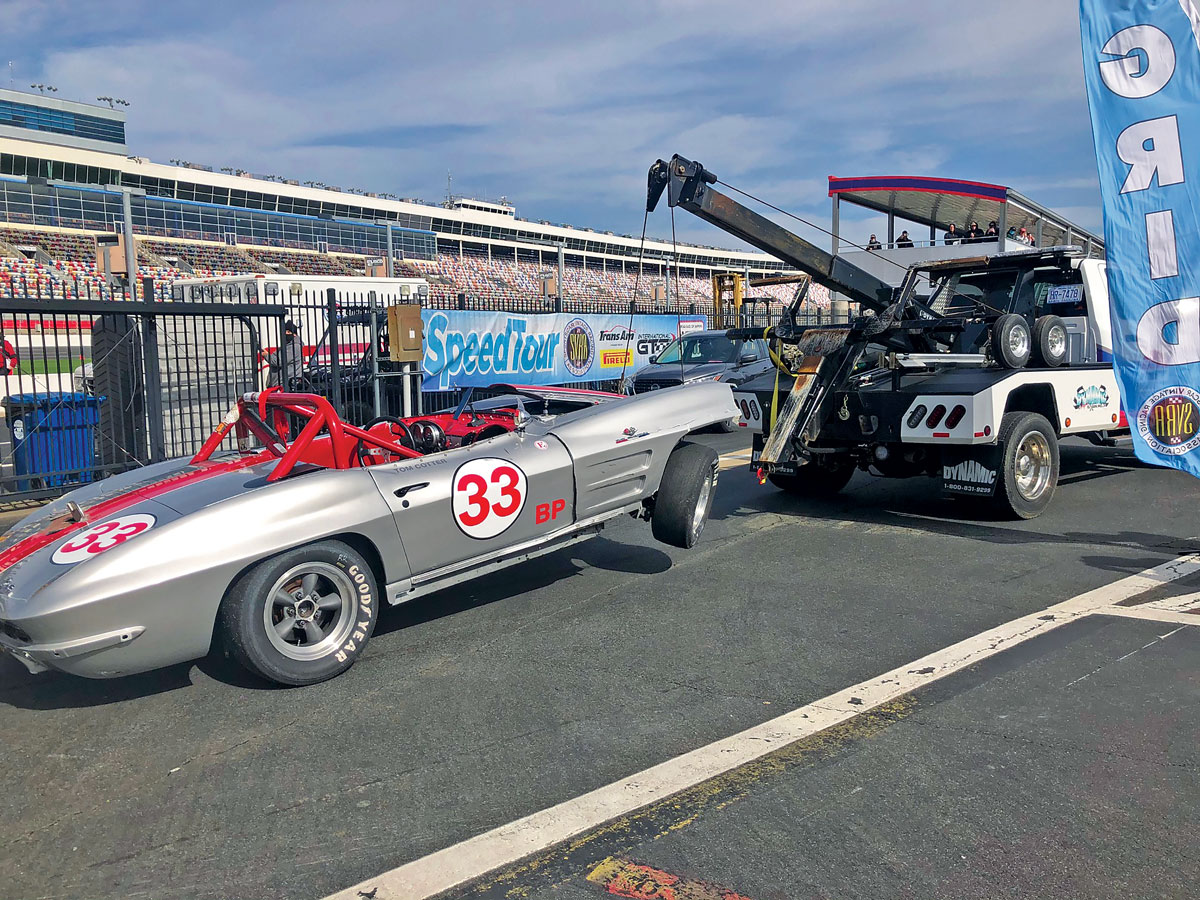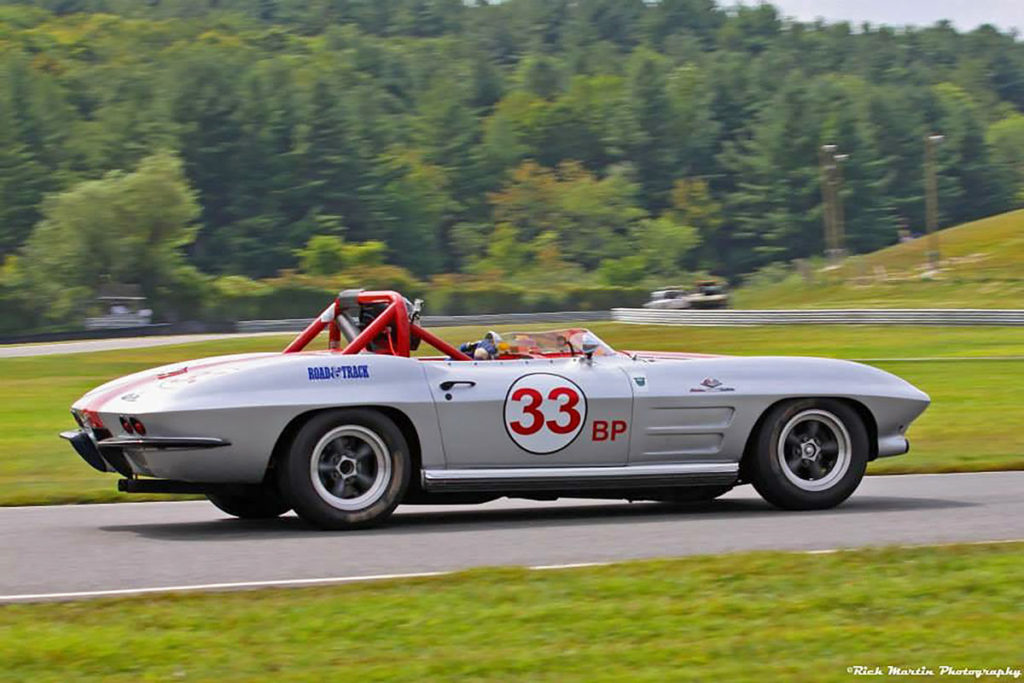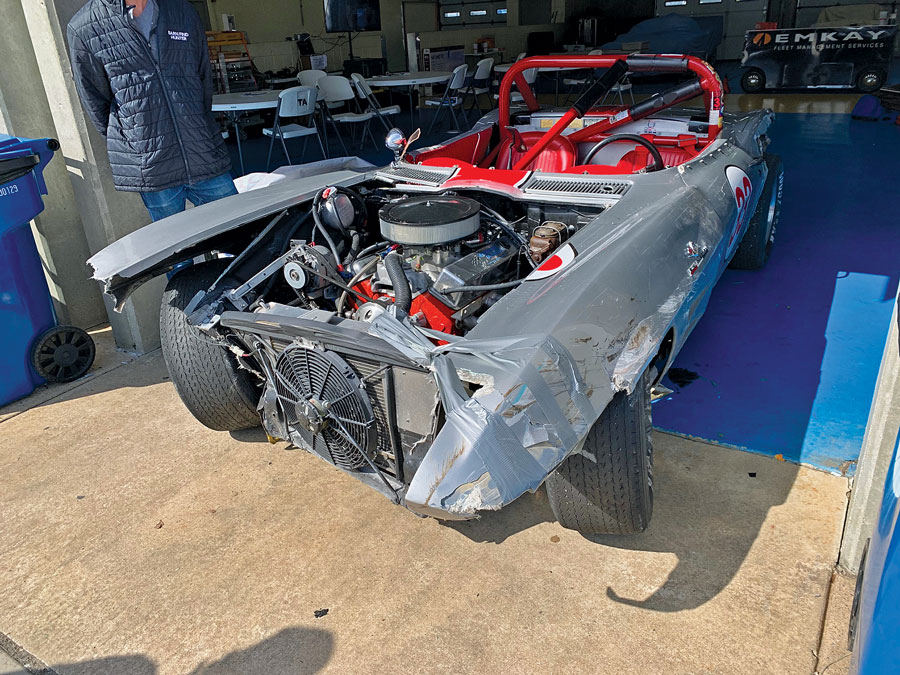
As I sat on the pre-race grid, I did the same thing I’ve done for 42 years while waiting for the race to start. I cinched up my helmet strap, tightened the seat belts and checked my mirrors. And worried about how the race might unfold.
My 1964 Corvette was one of the few true vintage race cars entered. I was surrounded by cars with huge fender flares, big tires and hundreds more horsepower. Those others were significantly faster than mine, which was concerning. So too were the concrete retaining walls and the banked turns.
I had been Charlotte Motor Speedway’s public-relations director in the 1980s, but racing there never appealed to me. I enjoy traditional road courses like Virginia International Raceway, Lime Rock Park and Watkins Glen. But because of the pandemic, I hadn’t raced in almost 18 months. Plus, the track is only 20 minutes from my home, so I could sleep in my own bed every night.
As I waited for the signal to fire up our engines, I never imagined that within just a few minutes I’d be at death’s door.
Behind the wheel
A quick biography on my Corvette: It has been a race car since 1965. It’s an authentic vintage racer powered by a 327-cid V8 with a Muncie 4-speed gearbox. Its West Coast racing history includes the SCCA B-Production track record at Riverside Raceway. I must sound like a proud papa, but I am serious when I say it is often one of the prettiest cars in the paddock. Even Ford guys love my Corvette. Perhaps in high-school, many of us dreamed of owning a similar car.
A couple of days earlier I had trailered my car into the garage area, which was rather sterile when compared to the landscaping at most road courses.
I did not enjoy my two practice sessions. The car pulled hard toward the outside concrete wall on the 24-degree banking. I nervously applied more throttle but thought the car might swap ends at speed.
The entrance to the infield course, a narrow passage bordered by concrete retaining walls, also got my attention. I have heard drivers complain about street circuits, where the concrete walls prevented overtaking and left no margin for error. Little did I know…

A cold morning
Saturday morning dawned sunny but brisk. Our first race would be at 9 a.m. I remembered the racers’ mantra: “Cold track plus cold tires equals cold cash,” meaning that we all needed to play nicely for a couple of laps until our tires warmed up, lest we do some damage.
About a dozen cars took the pace lap, with all the drivers swerving back-and-forth trying to build heat into our tires. If someone had told me that 10 seconds after the green flag dropped, I’d be upside-down, I never would have believed them.
In front of me was a Corvette, beside me was a Corvette and behind me was a Corvette. At the green flag, we all accelerated the short distance on the wide NASCAR oval before the sharp left onto the narrow “Roval” road course.
The driver of an IROC Pontiac Firebird, which started somewhere in front of me, apparently gave his cold tires too much throttle. Unbeknownst to me, he was taking a wide, wild ride, rapidly coming in from my left, perpendicular to the direction of race traffic. At the last second, he drove in front of me, first taking out the Corvette that had been on my left. Then he hit me.

Pretzel logic
From this moment, things happened quickly, yet so slowly.
I drove straight into the other Corvette, which became a ramp that vaulted my car at least 15 feet into the air. This was according to my son Brian, who was spectating at that corner. From that moment, things slowed down, as I stared out of my helmet at flying fiberglass, blue sky, tires and then darkness.
I actually had time to think, I wonder if this is how it ends? I wonder if this is what it feels like just before you die?
I saw my steering wheel bend in my hands like a pretzel. It seemed that during those milliseconds I could have written a novel.
When the car finally came to a stop, I hung upside-down, suspended by my harness. Everything was initially quiet, then I heard voices coming closer. I wondered if I had any broken bones. Was I bleeding? I had no pain except for my thumb, a result of the bending steering wheel.
I remembered watching the Bahrain Formula One race last season, where Romain Grosjean escaped an almost certain death by quickly exiting his flaming race car after it collided with a steel barrier. Not knowing if my car was leaking fuel, I decided to get the hell out.
I twisted the seat-belt buckle and dropped three feet onto my helmet. Ouch. But I was able to squeeze under the door and quickly escape the wreck.
The emergency crew had just arrived and made me sit down as they appraised my condition. Besides being shook up and having a sore rib, I felt pretty okay.
Death averted
Brian saw me climb out of the car and jumped up and down to get my attention. When I crossed the track, he was hysterical, thinking he had just witnessed his father’s death.
I computed that if my car had traveled just five feet farther, landing upside-down on the concrete barrier instead of the tire wall, I probably wouldn’t be writing this story. I believe that my Corvette kept bouncing and spiraling on the soft tire wall, dispensing energy as it traveled. Had I hit with a sudden impact — similar to Dale Earnhardt’s or Neil Bonnet’s NASCAR crashes — the immediacy would have left me critically injured.
Back in the garage, friends and strangers gathered to make sure I was all right. When a flatbed delivered my car, someone said that I had the nicest car before the race and the ugliest afterwards.
Brian was very angry at the driver who had caused the accident, but I reminded him that we risk life and limb every time we go out onto the track, and that drivers are responsible for their own crash damage. There is no insurance policy for on-track racing accidents that I know of. Vintage racing is the most extreme use of a classic, valuable automobile and the polar opposite of the trailer-queen approach. Putting one’s life and car at risk on a racetrack seems ludicrous to some, yet completely natural to others. I fall into the latter category.
The happy ending
I avoided making eye contact with the Firebird driver, sensing he’d be defensive, probably embarrassed, and looking to place blame on someone else.
I calculated the total accident damage likely exceeded $100,000 among all three cars, mine probably accounting for half that amount. But at least nobody was killed.
This was supposed to be the end of the story, but a little while later a surprise arrived in the mail. The “bad guy” in the Firebird sent me a check for $25,000. Wow!
I’ve spent my entire life in amateur and professional racing, and this was a new one on me. Usually, drivers’ egos are too inflated to admit guilt. When I called to thank him, he apologized. We spent a few minutes on the phone, and became friends, sort of. We made a promise that we’d get together the next time we were at the same event. “I feel so bad for the damage I caused to you and your car,” he said, “It makes me feel good to contribute toward the repair.”
When I told this story to my friend, professional driver Max Papis, he said he got goosebumps. “I have never heard of anything like this in my entire racing career,” he said.
So I have my work cut out for me now, with at least a year’s worth of repairs to make my once-beautiful Corvette beautiful again. But somehow, this story now has a happy ending. ♦
Tom Cotter is a seasoned vintage racer and longtime automotive and motorsport public-relations and marketing executive. He has written 16 automotive books, many on the subject of automotive archaeology. His searches for old cars led to the creation of “Barn Find Hunter,” an original video series that has now logged over 100 episodes on YouTube.